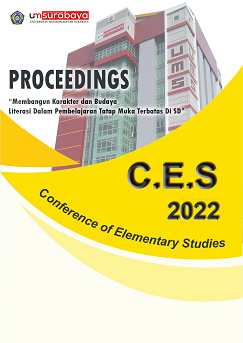MEDIA PEMBELAJARAN INTERAKTIF DALAM PENERAPAN BLENDED LEARNING SELAMA TATAP MUKA TERBATAS DI SEKOLAH DASAR
Abstrak
Covid-19 has a broad impact on educational institutions, this outbreak brings various real challenges in various aspects, one of which is in the world of education. On the other hand, if viewed from the positive side, this outbreak can provide a unique opportunity to test students' preferences in situations where those who initially did face-to-face learning were replaced with blended learning systems. Blended learning is currently being discussed because the learning process in the classroom tends to be boring and the development of technology is increasingly widespread. Blended learning is a learning implementation system that combines the advantages of e-learning, the advantages of face-to-face, and practice. This learning integrates technology and online learning materials with conventional face-to-face classroom activities. However, in its implementation, blended learning still requires the application of interactive learning media so that learning objectives can be achieved optimally. This study aims to determine; (1) knowing the relevance of applying blended learning during limited face-to-face meetings in elementary schools; (2) to determine the application of interactive learning media used with blended learning-based learning systems. The method used in this study is a qualitative description method using the type of literature study research, namely by collecting literature data, reading and taking notes and processing research materials. The literature collected is literature that meets the inclusion criteria, which contains elements of keywords in blended learning, interactive media, and elementary school.
Â
Keywords: Blended learning, interactive media, elementary schoolÂReferensi
Balasubramaniam, S. M., Bhargava, S., Agrawal, N., Asif, R., Chawngthu, L., Sinha, P., Kumar, S., & Sood, B. (2018). Blending virtual with conventional learning to improve student midwifery skills in India. Nurse Education in Practice, 28(November 2016), 163–167. https://doi.org/10.1016/j.nepr.2017.10.028
Berga, K. A., Vadnais, E., Nelson, J., Johnston, S., Buro, K., Hu, R., & Olaiya, B. (2021). Blended learning versus face-to-face learning in an undergraduate nursing health assessment course: A quasi-experimental study. Nurse Education Today, 96(2001). https://doi.org/10.1016/j.nedt.2020.104622
Chiu, T. K. F. (2021). Digital support for student engagement in blended learning based on self-determination theory. Computers in Human Behavior, 124(2001). https://doi.org/10.1016/j.chb.2021.106909
Clement, M., Vandeput, L., & Osaer, T. (2016). Blended learning Design: A Shared Experience. Procedia - Social and Behavioral Sciences, 228, 582–586. https://doi.org/10.1016/j.sbspro.2016.07.089
Heo, H., Bonk, C. J., & Doo, M. Y. (2022). Influences of depression, self-efficacy, and resource management on learning engagement in blended learning during COVID-19. The Internet and Higher Education, 54(April), 100856. https://doi.org/10.1016/j.iheduc.2022.100856
Kaur, M. (2013). Blended learning - Its Challenges and Future. Procedia - Social and Behavioral Sciences, 93, 612–617. https://doi.org/10.1016/j.sbspro.2013.09.248
Klentien, U., & Wannasawade, W. (2016). SainsLangsung Pengembangan model blended learning dengan laboratorium IPA virtual untuk siswa sekolah menengah. 217, 706–711.
Koſar, G. (2016). A Study of EFL Instructors⿿ Perceptions of Blended learning. Procedia - Social and Behavioral Sciences, 232, 736–744. https://doi.org/10.1016/j.sbspro.2016.10.100
Krasnova, T. (2015). A Paradigm Shift: Blended learning Integration in Russian Higher Education. Procedia - Social and Behavioral Sciences, 166, 399–403. https://doi.org/10.1016/j.sbspro.2014.12.543
Lapitan, L. D., Tiangco, C. E., Sumalinog, D. A. G., Sabarillo, N. S., & Diaz, J. M. (2021). An effective blended online teaching and learning strategy during the COVID-19 pandemic. Education for Chemical Engineers, 35(2001), 116–131. https://doi.org/10.1016/j.ece.2021.01.012
Mali, D., & Lim, H. (2021). How do students perceive face-to-face/blended learning as a result of the Covid-19 pandemic? International Journal of Management Education, 19(3). https://doi.org/10.1016/j.ijme.2021.100552
Matukhin, D., & Zhitkova, E. (2015). Implementing Blended learning Technology in Higher Professional Education. Procedia - Social and Behavioral Sciences, 206, 183–188. https://doi.org/10.1016/j.sbspro.2015.10.051
Müller, C., & Mildenberger, T. (2021). Facilitating flexible learning by replacing classroom time with an online learning environment: A systematic review of blended learning in higher education. Educational Research Review, 34(November 2020). https://doi.org/10.1016/j.edurev.2021.100394
Nazarenko, A. L. (2014). Information Technologies in Education: Blended learning (an Attempt of a Research Approach). Procedia - Social and Behavioral Sciences, 154, 53–56. https://doi.org/10.1016/j.sbspro.2014.10.111
Okaz, A. A. (2015). Integrating Blended learning in Higher Education. Procedia - Social and Behavioral Sciences, 186, 600–603. https://doi.org/10.1016/j.sbspro.2015.04.086
Rahman, N. A. A., Hussein, N., & Aluwi, A. H. (2015). Satisfaction on Blended learning in a Public Higher Education Institution: What Factors Matter? Procedia - Social and Behavioral Sciences, 211(September 2011), 768–775. https://doi.org/10.1016/j.sbspro.2015.11.107
Ruokonen, I., & Ruismäki, H. (2016). E-Learning dalam Musik : Studi Kasus Penyusunan Kelompok Belajar. 217, 109–115.
Stecyk, A. (2009). E-learning i blended learning w edukacji. Charakterystyka projektu LAMS WZiEU. Przedsiębiorczość - Edukacja, 5, 373–380.
Tomej, K., Liburd, J., Blichfeldt, B. S., & Hjalager, A.-M. (2022). Blended and (not so) splendid teaching and learning: Higher education insights from university teachers during the Covid-19 pandemic. International Journal of Educational Research Open, 3(November 2021), 100144. https://doi.org/10.1016/j.ijedro.2022.100144
Yalçınkaya, D. (2015). Why is Blended learning for Vocationally Oriented Language Teaching? Procedia - Social and Behavioral Sciences, 174, 1061–1068. https://doi.org/10.1016/j.sbspro.2015.01.795
Yigit, T., Koyun, A., Yuksel, A. S., & Cankaya, I. A. (2014). Evaluation of Blended learning Approach in Computer Engineering Education. Procedia - Social and Behavioral Sciences, 141, 807–812. https://doi.org/10.1016/j.sbspro.2014.05.140
Husamah. (2014). Pembelajaranbauran (blended learning) Terampil Memadukan Keunggulan Pembelajaran Face-To-Face, Elearning Offline-Online, dan Mobile Learning. Jakarta: Prestasi Pustaka.
Sari,M. (2016). Blended learning, model pembelajaran abad ke-21 di perguruan tinggi. Ta'dib, 17(2), 126-136.






